By Ruth Oron
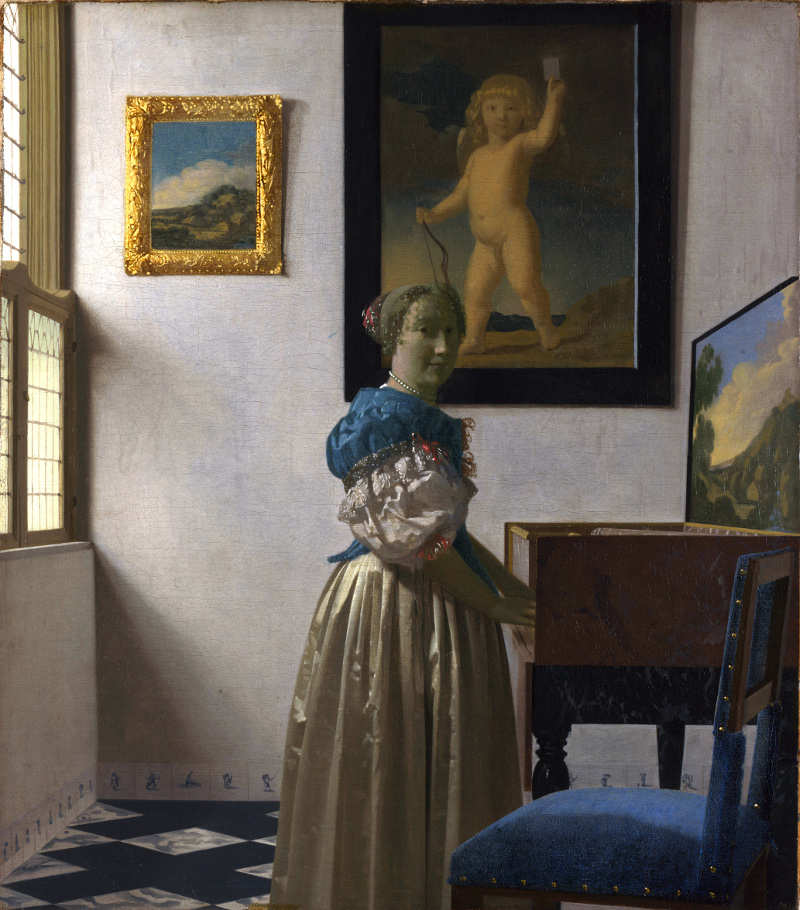
I will describe what I learned about kindness from the philosophy Aesthetic Realism, founded by the great American poet and educator Eli Siegel. I’m writing in relation to the painting in the National Gallery, London, that we’re looking at now: Jan Vermeer’s masterpiece Young Woman Standing at a Virginal.
There is no more urgent subject for every person—husband and wife, mother and child—and between nations than this: What does it mean to be truly kind?
First, I’ll say that Aesthetic Realism is completely new in world thought—including in its showing that there is a deep, inseparable relation between art and life, and that we can actually learn from the technique of art how we want to be in our lives. “All beauty is a making one of opposites,” Eli Siegel explained, “and the making one of opposites is what we are going after in ourselves.”
I. What Is Kindness?
Like most people, I wanted to feel I was a kind person. But also like most people, I wanted to be strong. In an Aesthetic Realism consultation I had in New York City, I told my consultants that I was worried about how I went from being warm to people at one moment to being aloof and severe the next. In consultations a person’s individual life questions are understood and explained through the principles of Aesthetic Realism. My consultants asked me to read this definition of kindness by Eli Siegel: “Kindness is that in a self which wants other things to be rightly pleased.” “What does it mean for a person to be rightly pleased?” they asked, and they explained: “Kindness is not just saying, ‘Oh yes, I want to be nice to you and give you things.’ Kindness begins with whether we really want to think about another human being or an object.”
They showed me a reproduction of Jan Vermeer’s Young Woman Standing at a Virginal. I thought it was beautiful. Then, they asked, “Do you think in this painting Vermeer was kind? Was he kind to the objects in the room—say, the window? Was he thinking deeply about each object and their relation to each other?” I was surprised, but I felt, Yes. They asked:
“Do you think Vermeer wanted to understand how that window met light? How it was related to that triangular shadow? Do you think he wanted to see what the window had to do with the woman at the virginal? Was he interested in the color of the light that came through the window in relation to the blue in that picture?”
This was the beginning of my learning a new way of looking at art and at myself. My consultants asked further, “So, do you think kindness begins with wanting to see how one thing is related to other things?” And they explained, “Kindness is giving something everything it deserves, all its relations, all its meaning, or the hope to.”
This consultation, where my most intimate feelings were related to the lines and colors, lights and shadows of this 17th century masterpiece, changed the way I saw the world. I began to realize that I had seen people mainly in relation to myself and how they treated me; I wasn’t interested in, and even resented, their relation to other things—to the wide universe.
II. Universe and Object: As Seen by Vermeer
In Eli Siegel’s groundbreaking Fifteen Questions “Is Beauty the Making One of Opposites?,” he asks this question, which says so much about the work of Jan Vermeer:
Universe and Object: Does every work of art have a certain precision about something, a certain concentrated exactness, a quality of particular existence?—and does every work of art, nevertheless, present in some fashion the meaning of the whole universe, something suggestive of wide existence, something that has an unbounded significance beyond the particular?
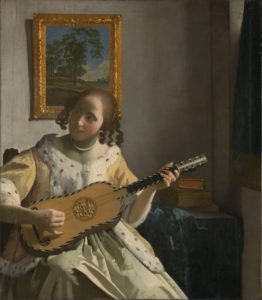
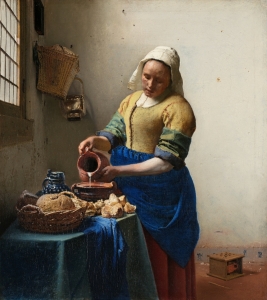
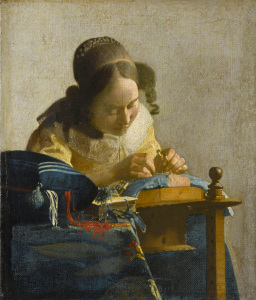
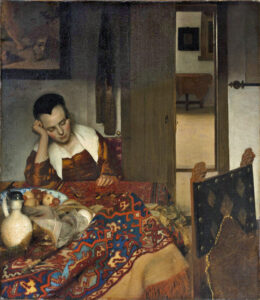
Whether Vermeer painted a woman playing a guitar (also in the National Gallery), a woman in the kitchen, another making lace, or even one who’s asleep at a table, he showed the opposites of the universe are there in the domestic. Inside these Dutch interiors, in sunlight and shadow on small canvasses, there is an almost indescribable depth and width.
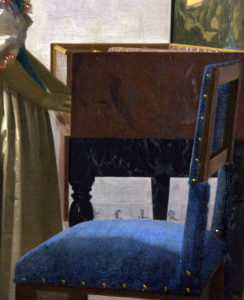 A large reason we feel this relation of domesticity and universality is in how Vermeer paints light. Light sparkles and gleams on the edge of the frame, on the satin fabric, on the points of metal studding the chair. It can be asked: Does this light, coming from the window have us know each object more deeply and also see its mystery? Does it make us feel, as Mr. Siegel so exactly described it, “something suggestive of wide existence”?
A large reason we feel this relation of domesticity and universality is in how Vermeer paints light. Light sparkles and gleams on the edge of the frame, on the satin fabric, on the points of metal studding the chair. It can be asked: Does this light, coming from the window have us know each object more deeply and also see its mystery? Does it make us feel, as Mr. Siegel so exactly described it, “something suggestive of wide existence”?
Hubert von Sonnenburg writes in the Metropolitan Museum Bulletin:
Perhaps the most extraordinary characteristic of Vermeer’s work is the way light is channeled, diverted, reflected with total logic from one surface to another, infusing space, color and form with a luminous unity.
Vermeer uses light to show each particular thing, and also the relation among things. This is what, in my life years ago, I did not do. I would focus intensely on one person in a way that was disproportionate and unrelated to other things. In his magnificent lecture on Vermeer, Eli Siegel said:
[T]he meaning of something in the long run is what it has to do with other things and how it explains the world in general and what the world is up to….Vermeer is looking for meaning, and is saying, “All these surfaces and all these shapes tell me something about everything, and they tell me something about me.”
III. Seeing Relation Makes for Kindness

As this young woman stands looking at us from the center of the canvas, with her sweet, mysterious smile, Vermeer, through colors and shapes, shows her relation to other things. The warm, white rectangle of the window on the left is the same warm white he uses to paint the highlights on the fabric of her dress, and it is also like the white of the clouds we see in the landscape painted on the inside of the lid of the virginal—a landscape that takes us into wide, deep space.
Very surprisingly, this painting has three pictures within it. The small landscape high on the wall at the left takes us into deep space, and it too has the same warm and cool blues, browns, and white we see in the woman’s garment.
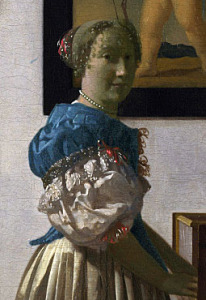
The fabric of the woman’s sleeves combines the soft whiteness of the clouds and the crisper angles of the rocks. This combination of hardness and softness, warmth and coolness is also in her mysterious and yet direct expression. Every woman has a question about how to see herself as hard and soft—I certainly have—and Vermeer is kind in showing that the same opposites that can puzzle us are also in the earth itself, in mountains and clouds. When we are truly kind—that is, when we want a person to be “rightly pleased”—hardness and softness work together for the same purpose, as they do so beautifully here.
Above and behind the head of the woman, and between the two landscapes, is a large painting of Cupid. This is the most surprising thing in the painting—the way this cupid is painted so boldly, almost as if he is rising out of the lady’s head. What is the meaning of this?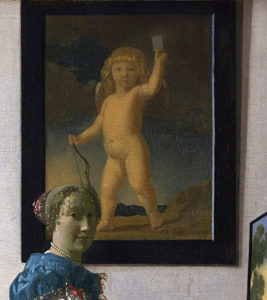
Critics have felt Vermeer was saying something about the thoughts of this woman, who pauses in her playing to look at us, or at the artist. What is Vermeer saying by placing the god of love here in this way? Is he saying that even the most personal thoughts about love must be seen as in the midst of the whole world, and in the light? A sentence about Vermeer I care for is this one by Max J. Friedlander in his book Landscape, Portrait, Still-Life: “He is mysterious in broad daylight.”
Everything in this painting is both clear and mysterious. The enigmatic smile on the face of the woman, with its play of light and shadow, makes her seem both straightforward and unfathomable. Often I would get angry when I didn’t know what a person was thinking, feeling immediately that it was against me. I didn’t see what Vermeer shows—that a person is mysterious and has a right to be, because everything in the world is both clear and mysterious too.
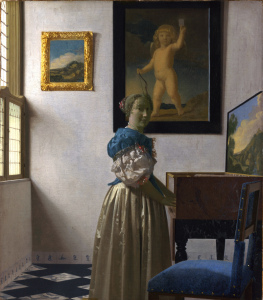
The light from the window, which illuminates everything, has a source we cannot see; the landscape on the right goes off the canvas, so that part of it is unknown; and the chair, the nearest thing to us, is in shadow as well as light, and turned slightly away from us.
We feel that Vermeer is kind in the way he looked at this young woman and painted her because he wanted to see her meaning, what she has to do with other things. What Vermeer quietly insists on here is that a person has the structure of the whole world in her—the opposites: hardness and softness, straight line and curve, surface and depth, light and shadow, the touchable and the untouchable.
I’m very glad to have told something of what I’ve learned from Aesthetic Realism about kindness. As Ellen Reiss, Chairman of Education, explains in The Right of Aesthetic Realism to Be Known:
We need to hope to see another human being the way art sees an object: as fully real—which means standing for the whole world. There is no need more urgent. The other way—contempt, the lessening of people, the seeing of them in terms of whether they do what we want—is the way of seeing that has made for every cruelty in history….Aesthetic Realism is the great philosophy which shows that…the one way of seeing the world which is fully kind, safe, and sane is the aesthetic way. And do the people of the world need to learn how to see in a way that is kind, safe, and sane!
Ruth Oron, born in Israel, is an essayist, sculptor, and Aesthetic Realism Associate. This article is based on a talk Ruth Oron presented in the Terrain Gallery series titled: Aesthetic Realism Shows How Art Answers the Questions of Your Life!
